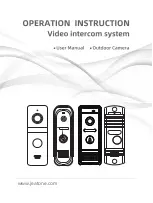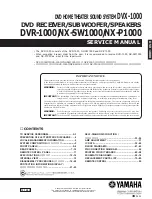
Glossary of Audio Terms 11
g
lossary
oF
a
udIo
t
erms
AC .
Abbreviation for alternating current.
Active crossover .
Uses active devices (transistors, ICs,
tubes) and some form of power supply to operate.
Amplitude .
The extreme range of a signal. Usually mea-
sured from the average to the extreme.
Arc .
The visible sparks generated by an electrical dis-
charge.
ATF .
The
abbreviation for advanced thin film.
Bass .
The lowest frequencies of sound.
Bi-Amplification .
Uses an electronic crossover, or line-
level passive crossover, and separate power amplifiers for
the high and low frequency loudspeaker drivers.
Capacitance .
That property of a capacitor which determines
how much charge can be stored in it for a given potential
difference between its terminals, measured in farads, by
the ratio of the charge stored to the potential difference.
Capacitor .
A device consisting of two or more conducting
plates separated from one another by an insulating mate-
rial and used for storing an electrical charge. Sometimes
called a condenser.
Clipping .
Distortion of a signal by its being chopped
off. An overload problem caused by pushing an ampli-
fier beyond its capabilities. The flat-topped signal has
high levels of harmonic distortion which creates heat in a
loudspeaker and is the major cause of loudspeaker com-
ponent failure.
CLS .
The
abbreviation for curvilinear line source.
Crossover .
An electrical circuit that divides a full band-
width signal into the desired frequency bands for the
loudspeaker components.
dB (decibel) .
A numerical expression of the relative loud-
ness of a sound. The difference in decibels between two
sounds is ten times the Base 10 logarithm of the ratio of
their power levels.
DC .
Abbreviation for direct current.
Diffraction .
The breaking up of a sound wave caused by
some type of mechanical interference such as a cabinet
edge, grill frame or other similar object.
Diaphragm .
A thin flexible membrane or cone that vibrates
in response to electrical signals to produce sound waves.
Distortion .
Usually referred to in terms of total harmonic
distortion (THD) which is the percentage of unwanted har-
monics of the drive signal present with the wanted signal.
Generally used to mean any unwanted change introduced
by the device under question.
Driver .
See transducer.
Dynamic Range .
The range between the quietest and the
loudest sounds a device can handle (often quoted in dB).
Efficiency .
The acoustic power delivered for a given elec-
trical input. Often expressed as decibels/watt/meter
(dB/w/m).
ESL .
The
abbreviation for electrostatic loudspeaker.
Headroom .
The difference, in decibels, between the peak
and RMS levels in program material.
Hybrid .
A product created by the marriage of two different
technologies. Meant here as the combination of a dynam-
ic woofer with an electrostatic or ATF transducer.
Hz (Hertz) .
Unit of frequency equivalent to the number of
cycles per second.
Imaging .
To make a representation or imitation of the
original sonic event.
Impedance .
The total opposition offered by an electric
circuit to the flow of an alternating current of a single fre-
quency. It is a combination of resistance and reactance and
is measured in ohms. Remember that a speaker’s imped-
ance changes with frequency, it is not a constant value.
Inductance .
The property of an electrical circuit by which
a varying current in it produces a varying magnetic field
that introduces voltages in the same circuit or in a nearby
circuit. It is measured in henrys.






























